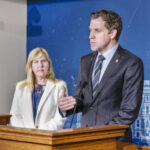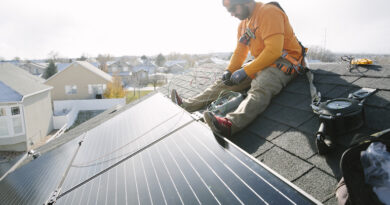California joint agency report finds reaching carbon-free goal will require up to 6 GW of new renewable resources annually
The California Energy Commission (CEC), California Public Utilities Commission (CPUC) and California Air Resources Board (CARB) released the first joint agency report and a summary document examining how the state’s electricity system can become carbon free by 2045.
The report is the initial analysis called for in Senate Bill 100 (SB 100, De León, Chapter 312, Statutes of 2018), the state’s landmark policy requiring that renewable and zero-carbon energy resources supply 100% of electric retail sales to customers by 2045. The bill was signed into law in 2018 and calls for these resources to replace fossil fuels for generating electricity in the state.
The 178-page report finds that the goals of SB 100 can be achieved in different ways, but reaching them will require significant investments in new and existing technologies and an increased, sustained build-out of clean energy projects to bring new resources online. The report modeled various scenarios to examine sample paths to carbon-free energy. It will be followed with additional analyses of energy reliability and evolving conditions.
“The results of this preliminary analysis show that it is indeed possible to achieve a 100% clean electricity future. The threat posed by climate change requires us to think and act boldly today,” said CEC Chair David Hochschild. “Building a carbon-free grid is foundational to achieving our climate goals and will provide good paying jobs and cleaner air to those who need it most.”
Highlights from the report include the following:
- To reach the 2045 target while electrifying other sectors to meet the state’s economy-wide climate goals, California will need to roughly triple its current electricity grid capacity.
- California will need to sustain its expansion of clean electricity generation capacity at a record-breaking rate for the next 25 years. On average, the state may need to build up to 6 GW of new renewable and storage resources annually. By comparison over the last decade, the state has built on average 1 GW of utility solar and 300 MW of wind per year. Over the next three years, electricity providers regulated by the CPUC will add another 8 GW of clean energy resources.
- In addition to social benefits such as less air pollution and improved public health, transitioning to a carbon-free electric system will also create thousands of jobs such as manufacturing and installing wind turbines and solar panels and developing new clean energy technologies.
- Modeling of the core scenario for achieving 100% clean electricity showed a 6% increase in total annual electricity system costs by 2045, compared to the estimated cost of achieving 60 percent renewable electricity by 2030.
- Advancements in emerging technologies, increased demand flexibility and cost declines in existing technologies may decrease the total electricity resource requirements and implementation costs. These topics, along with reliability, will be examined more closely in future analyses.
- A clean electricity grid is necessary to achieve economy-wide carbon neutrality. Using clean electricity to power transportation, buildings and industrial operations helps decarbonize these sectors of the economy, which, along with electricity generation, account for 92% of the state’s carbon emissions.
“Achieving 100% clean electricity by 2045 is not only a bold pursuit, but a wise one,” said CPUC president Marybel Batjer. “Such action is required to avoid the worst impacts and costs of climate change and to ensure the delivery of safe, affordable, reliable and clean power to all Californians.”
California has already made significant progress toward a clean energy future. Due to many efforts that promote renewable energy, energy efficiency and the storage technologies needed to retire fossil fuel resources, the state’s electricity mix is already more than 60% carbon free. About 36% of that comes from renewable sources, predominantly wind and solar.
“We know reaching carbon neutrality is critical to avoiding the worst impacts of climate change and achieving our climate goals,” said CARB Chair Liane Randolph. “Zero-carbon electricity is also critical for displacing combustion of fossil gas and petroleum to deliver needed public health benefits, especially in our frontline communities.”
The report was developed using computer modeling and incorporates existing studies; the state’s energy, climate, equity and public health priorities; and information gathered through a yearlong series of public workshops throughout the state.
Although the report examines the challenges and opportunities for a carbon-free electricity system, the three agencies highlight that it is only a first step in an ongoing effort. The agencies also note that costs, performance and innovations in zero-carbon technologies will change over the next 25 years.
Additional Multiagency Actions
The CPUC, California Independent System Operator and CEC are implementing actions to prevent electricity shortages and ensure delivery of clean, reliable and affordable energy in response to the August 2020 extreme heat wave. Among the actions are expediting the regulatory and procurement processes to develop additional resources that can be online by summer 2021 and ensuring that the generation and storage projects under construction are completed as scheduled.
This year, CARB will also begin the process to update the Assembly Bill 32 Climate Change Scoping Plan, which will assess progress toward reducing GHG emissions 40% below 1990 levels by 2030 and chart the path to carbon neutrality by 2045. The SB 100 report is one of the foundational reports that will inform the development of the next scoping plan. The CARB board will consider acting on the scoping plan in late 2022.
For details on the report, view the full SB 100 report and summary.
News item from the California Energy Commission
<!–
–>
Original Source: https://www.solarpowerworldonline.com/2021/03/california-joint-agency-report-carbon-free-goal-renewables/













